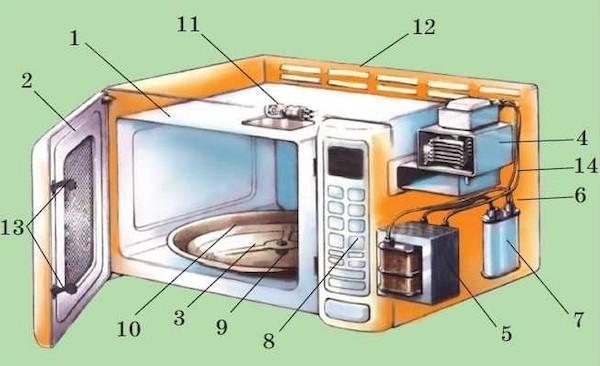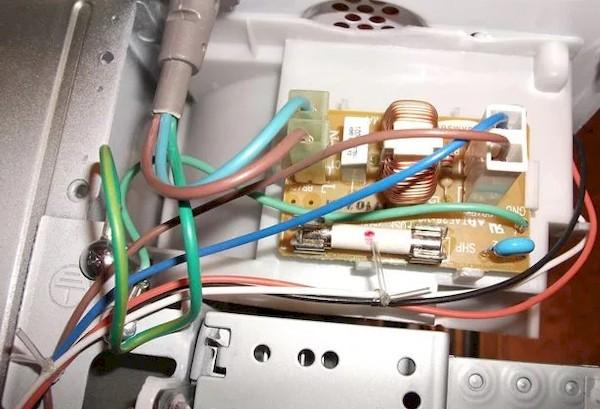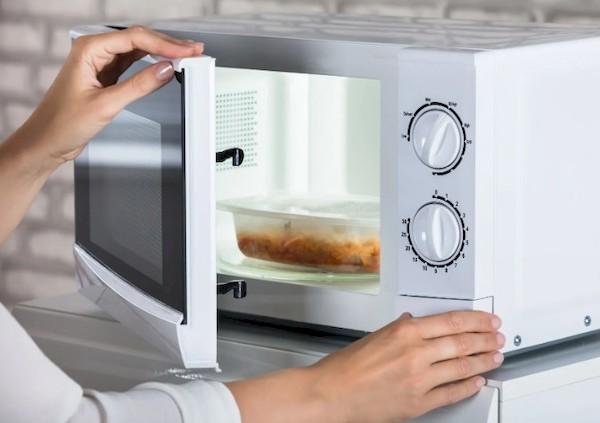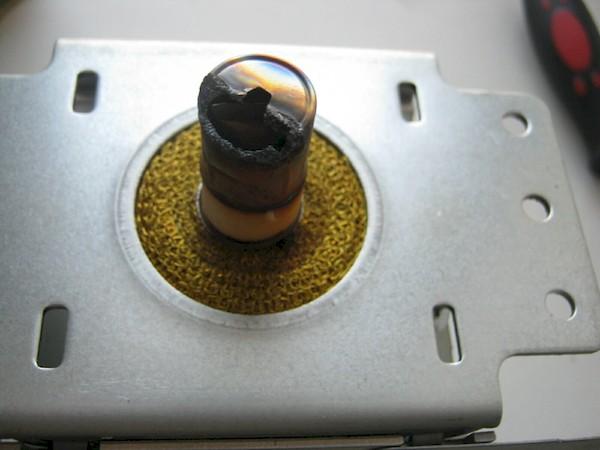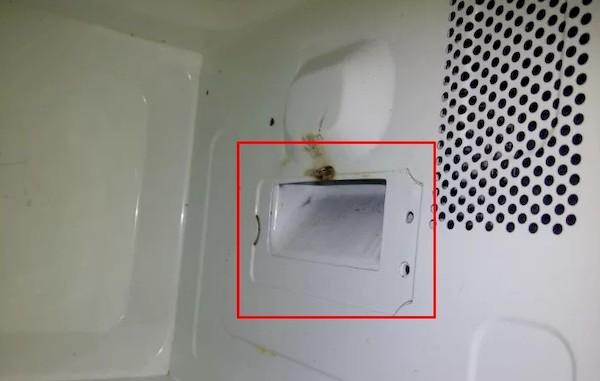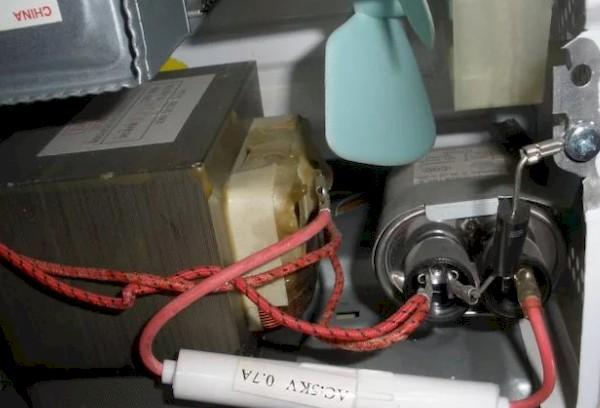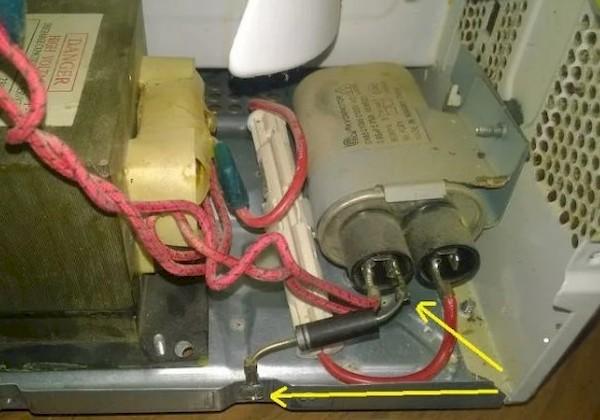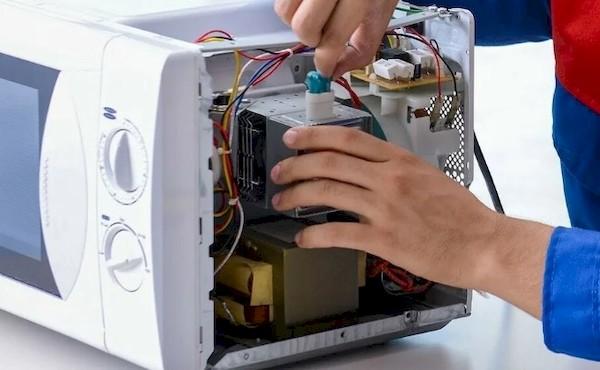Why the microwave does not heat food: reasons, solutions and prevention of breakdowns
The reasons why a microwave does not heat can be very diverse. The problem is not always with the device itself, when some important part fails. It happens that this happens due to improper operation or under the influence of external factors - for example, insufficient voltage in the network. The owner can eliminate some causes on his own, while others require professional repairs.

How does a microwave oven work?
To establish the reason why the microwave oven stopped heating food, it was easier to first understand its structure and take a general look at how it works.
Setting, starting and canceling modes is done from an external control unit. It can be electromechanical (with buttons and round switches) or digital (with a touch panel). In both the first and second cases, commands are transmitted using conductors.
The working chamber of the microwave oven is illuminated using an incandescent lamp. Most often it is located inside the air duct.
Heating is carried out by microwaves generated by the magnetron. This is a small device located behind the control panel. Its power is provided by a transformer, capacitor and diode. In many models, part of this circuit also includes a high-voltage fuse that protects the transformer from overload.
The magnetron heats up during operation and needs to be cooled. A fan is provided for these purposes. Thus, the warm air generated by the magnetron is transferred to the working chamber of the device, which speeds up the heating of food. The resulting steam is removed through special holes along with excess air.
Microwave ovens turn on only when the door is tightly closed - this is ensured by microswitches. Depending on the model of the device, there can be from 2 to 5 pieces. When the door is closed, the microswitch buttons are pressed, the circuit is closed, power is supplied, and the work cycle begins. Unless the buttons are pressed down properly, the oven will not work.
Simple causes of malfunction
First, let's look at cases when a microwave oven stops heating food not because of a malfunction of key elements, but for other reasons. Listed below are factors that may interfere with the correct operation of the device.
Insufficient mains voltage
For normal operation of the magnetron and high-quality heating/defrosting of products, a voltage of 220 V is required. If it is even slightly lower, the temperature will increase more slowly, which will accordingly affect the heating intensity.A stabilizer will help to avoid such “jumps”.
Another reason why a lack of voltage may occur is when other powerful household appliances are connected to the same line. When they operate simultaneously, a voltage deficiency may occur, which will also lead to the oven not heating well. Solving this problem is simple - you need to switch the rest of the equipment to another “branch” or, if possible, not turn it on while the microwave is running.
Broken cord or socket
The microwave will not turn on if the cord is damaged or there is no contact in the outlet. The first reason is quite simple to identify - just visually inspect the wire for damage to its integrity. If no external damage is found, you should test it with a multimeter.
When the cord is working, but the oven is not working, you need to check the outlet. To make sure that this is the problem, just connect the microwave to a different power source. If the device starts working, it means that there is a malfunction in the outlet from which it was previously powered.
Incorrect operating mode selected
In addition to heating, microwave ovens perform a number of other functions. And if the light is on inside the appliance, the platform is spinning and it is humming as usual, but the food remains cold, perhaps an inappropriate mode is turned on (for example, defrosting). All that is required in such a situation is to check the settings and activate the desired function.
A loose or faulty door
As mentioned above, the microwave turns on only after the door is completely closed until a characteristic click is heard. But the reason that it remains ajar is not always due to the owner’s carelessness; sometimes it is due to a malfunction of the latch.That is, the latch “hangs” in the “open” position, in which the power supply circuit is broken, and, accordingly, the heating or defrosting process does not start.
The opposite situation also happens when the latch “jams” in the closed position. In this case, the heating circuit is closed, but it is not possible to place or take away a plate of food, since the door is blocked and cannot be opened.
In both cases, the problem can be solved in two ways - by changing the faulty latch or the entire door.
Breakdowns requiring repair
We are talking about the failure of key components of the system. With such malfunctions, the owner often cannot independently determine what the cause is and how to eliminate it, and the help of a professional is required.
Fuse burned out
Structurally, this part is a glass flask with metal caps on the edges. Inside it there is a wire spring, one edge of which is soldered to the contact of the cap. When using a microwave oven, the soldering material gradually softens, the elastic force of the spring “spreads” the contacts, and the part fails.
If such a problem occurs, there are two solutions - to restore the soldering by carefully removing the cap and soldering the wire in place, or to replace the fuse completely. This part is inexpensive and is freely sold in specialized stores. Just to select the right spare part, you need to take the damaged fuse with you to the store and buy exactly the same one.
Magnetron malfunction
This is one of the most expensive elements of a microwave oven. Some of the breakdowns to which it is susceptible can be eliminated, but there are a number of cases when a complete replacement of the magnetron is required.
Removable breakdowns, when you only need to replace the failed component, include:
- burnout of the antenna cap;
- weakening of the upper magnet.
A complete replacement of the magnetron is necessary in the following cases:
- the filament has broken;
- element depressurization occurred;
- the integrity of the transition capacitor is damaged;
- The part has undergone natural wear and tear.
To understand that the reason is in the magnetron, you can perform a small test:
- Pour 2 glasses of water into a suitable container.
- Measure the temperature of the liquid and record the data.
- Place the water in the microwave, placing the container strictly in the middle of the rotating platform, and turn on the heating mode for 1 minute at maximum power.
- Re-measure the liquid temperature. If the indicator has increased by 19–36°C, the magnetron is working normally. When the temperature increases by less than 19°C, this indicates its malfunction.
In addition to a decrease in heating quality, problems with the magnetron can be indicated by extraneous sounds when the microwave is operating, as well as sparks and smoke.
Mica plate
This element is located on the wall of the heating chamber. Its functions are to distribute radiation evenly and protect the magnetron and other internal parts from fat and food particles.
The mica plate may fail for the following reasons:
- severe surface contamination;
- deformation;
- the appearance of cracks or through burnout.
In the first case, it is enough to remove the part and carefully clean it of fat and food particles. And if the plate is deformed or damaged, it will have to be replaced. If you continue to operate the microwave in this condition, it will lead to more serious damage.
Capacitor burned out
The capacitor's job is to level out surges in the mains voltage. When it fails, the microwave continues to turn on, the platform rotates, but the food does not heat up and extraneous noise appears.
You can check the condition of an element using a tester:
- if the arrow approaches the “infinity” mark, the part is functioning properly;
- there are small deviations - the capacitor is damaged, which is why it cannot work at full capacity and needs to be replaced;
- the arrow did not move - a serious breakdown occurred, as a result of which the element completely failed.
Important! When testing a capacitor, precautions must be taken - this element can retain an electrical charge, which can lead to electric shock.
Diode failure
A high-voltage diode performs the function of converting alternating current into direct current, and also passes charge in one direction and blocks its return flow. If this element breaks down, the microwave, just as in the previous case, starts a working cycle, rotates the platform, turns on the backlight, but the food is not heated. In addition, due to the large volume of heat generated, the capacitor overheats.
You can make sure that the reason is in the diode using a multimeter by measuring the resistance in both directions. The test is carried out with a power source of at least 9 volts. If the spare part is working, the results will be as follows:
- at “+” the diode will give the final resistance value;
- at “-” the device will indicate the infinity sign.
It is worth noting that correctly testing a high-voltage diode is quite a difficult task. For this reason, in most cases the part is not tested and replaced immediately.The parameters of the new diode must completely coincide with the previous one.
Inverter fault
An inverter is an intelligent control system for the operation of the device. It is this that determines the temperature of the product and the desired degree of heating. Operation and control are carried out using sensors, which, if they fail, provide incorrect information. This may cause the microwave to stop heating food.
The system cannot be repaired. If the inverter fails, it is replaced with a new one.
Prevention of breakdowns
You can extend the life of your microwave and avoid most breakdowns if you handle the device correctly.
When operating the oven, it is important to follow these simple rules:
- Heat food and defrost food only in suitable containers. The best option is special plastic containers for microwave ovens. But you can also use ordinary plates, the main thing is that there is no metal coating, golden or silver inclusions on them, otherwise the equipment will start to spark.
- When heating food in containers, do not close them tightly. Steam should come out of the container freely, and then be removed from the working chamber through special openings.
- Use a special plastic cap if food is heated in a container without a lid. This will protect some parts of the oven, such as the mica plate and door latches, from failure due to contamination by grease and food particles.
- Place the container with food strictly in the center of the rotating platform. This will distribute the heat evenly throughout the dish.
- Defrost and heat food in such volumes that they do not interfere with the rotation of the plate.For example, a large piece of meat or a long fish carcass may cling to the internal surfaces and impede the movement of the platform.
- Do not heat alcoholic beverages in the oven. Ethanol vapors, having penetrated to internal parts, especially those that are subject to heating during operation, can damage them. And if we are talking about strong types of alcohol, for example, vodka, with strong heating it can ignite.
- Do not use tees or extensions. The microwave oven must have its own, separate outlet. Otherwise, there may not be enough voltage for it to work correctly.
- Do not place heavy objects on the device cover. This will increase the load on a number of internal elements of the furnace and lead to their premature failure.
- Do not heat or attempt to “boil” eggs or other foods unsuitable for microwave ovens in a microwave oven.
- Do not turn on an empty stove - this harms the equipment.
- Close the door carefully, without slamming. Otherwise, the latches may break and the oven will stop turning on.
You also need to keep the external and internal surfaces clean and regularly clean them of dust, grease and food particles. Carbon deposits and other contaminants quite often cause breakdowns of various elements of the device.
